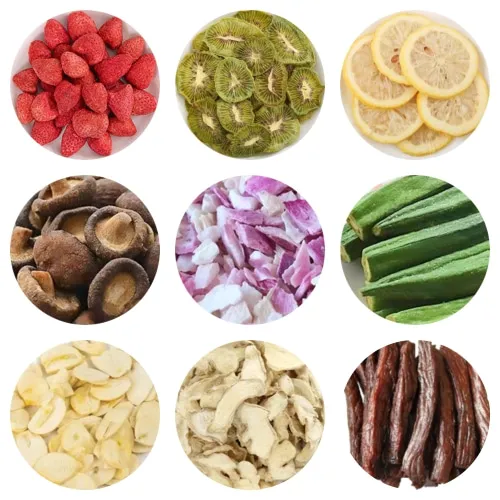Best Vegetables for Dehydrating (Beyond Just Peppers)
Discover how a dehydrator can transform everyday vegetables like carrots, tomatoes, and zucchini into nutrient-packed, shelf-stable ingredients that add flavor and convenience to your meals.
Dehydrating vegetables is an easy way to minimize food waste while creating versatile kitchen staples. While peppers are popular for drying, many other vegetables are equally suitable for the dehydrating process.
Carrots, tomatoes, and zucchini stand out as top choices because they dry evenly and maintain their delicious flavors. Here's what makes them special:
- Carrots: Become naturally sweet and crisp when dried, ideal for soups or healthy snacks. Their beta-carotene content remains preserved through dehydration.
- Tomatoes: Develop concentrated umami flavor, whether sun-dried or dehydrator-dried. Pro tip: cherry tomatoes dry quicker than sliced larger varieties.
- Zucchini: Thin slices turn into satisfying, chip-like crisps - a nutritious, low-calorie snack with excellent storage potential.
Expand your vegetable preservation repertoire with these options:
- Leafy greens (kale, spinach) – Perfect for transforming into flavorful seasoning powders.
- Root vegetables (beets, sweet potatoes) – Yield pleasantly chewy, naturally sweet dried treats.
- Mushrooms – Develop an intense earthy essence that enhances soups and stews.
Essential preparation techniques:
- Uniform slicing (1/8 to 1/4 inch) ensures even drying.
- Blanch carrots and beets beforehand to accelerate dehydration.
- Lightly salting tomatoes before drying enhances their flavor.
Using a dehydrator at 125–135°F preserves more nutrients compared to oven drying, while being faster and more reliable than traditional sun drying methods.
Curious about optimal drying times and techniques for specific vegetables? Let's examine the details in our next discussion.
Optimizing the Dehydrating Process for Different Vegetables
Achieving perfect dehydration requires tailored approaches for each vegetable type—consider thickness, prep methods, and drying times.
PAS: Not all vegetables dehydrate the same way. To create crispy, long-lasting results with your dehydrator, adapt your technique based on moisture content and texture. Here’s how to master the dehydrating process for various vegetables.
Key Variables by Vegetable Type:
- Preparation:
- Carrots: Peel and slice into ¼-inch rounds or sticks (thicker cuts take 8–12 hours).
- Tomatoes: Remove seeds and slice ½-inch thick (6–10 hours at 135°F/57°C).
- Zucchini: Use a mandoline for uniform ⅛-inch slices (5–8 hours).
2. Drying Times & Temperatures:
| Vegetable | Thickness | Temperature | Time Range |
|---|---|---|---|
| Bell Peppers | ¼-inch strips | 125°F/52°C | 7–10 hours |
| Mushrooms | ⅛-inch slices | 130°F/54°C | 4–6 hours |
| Kale | Whole leaves | 115°F/46°C | 2–4 hours |
Pro Tips for Vegetable Preservation:
- Blanch broccoli or cauliflower before drying to retain vibrant color.
- Stir root vegetable slices every 2 hours to ensure even drying.
- Herbs dry quickly (1–3 hours at 95°F/35°C)—dehydrate them separately.
Want to extend the shelf life of your dry vegetables? The next section covers smart storage solutions to keep them fresh longer.
Best Practices for High-Quality Dehydrated Vegetables
To produce premium dehydrated vegetables, focus on three key elements: precise temperature control, proper storage techniques, and avoiding common dehydrating pitfalls like uneven slicing or overcrowded trays.
Perfecting dehydrated vegetables goes beyond moisture removal—it's about locking in flavor, maintaining ideal texture, and preserving nutritional value while preventing spoilage. Here's your step-by-step guide to mastering the dehydrating process.
Temperature: The Make-or-Break Factor
Most vegetables dehydrate optimally between 125°F and 135°F (52°C-57°C). Delicate leafy greens like spinach require lower temperatures (95°F-105°F) to prevent scorching, while hardy root vegetables tolerate slightly higher heat. Exceeding 140°F will cook rather than dry your produce—a critical distinction in vegetable preservation.
Storage Solutions for Maximum Shelf Life
- Opt for airtight containers with oxygen absorbers
- Glass jars or vacuum-sealed bags deliver best results
- Maintain storage in cool, dark environments (ideal below 60°F)
- Always label containers with dehydration dates (typical lifespan: 6-12 months)
Top Dehydrating Mistakes and How to Fix Them
| Mistake | Consequences | Solution |
|---|---|---|
| Irregular slicing | Uneven drying | Use a mandoline for consistent 1/8"-1/4" cuts |
| Overcrowded trays | Poor air circulation | Leave 1/2" space between pieces |
| Skipping pretreatment | Color degradation | Blanch carrots/beans, treat apples with lemon juice |
| Skipping dryness test | Mold risk | Properly dried veggies snap—they shouldn't bend |
Pro Technique: For ultimate crispness, implement a "conditioning" phase—store dehydrated vegetables in jars for 7 days, shaking daily to check for condensation. If moisture appears, return them to the dehydrator for finishing.
Curious about how different vegetables—from peppers to root crops—vary in drying times and preparation methods? Our next section details specialized techniques for various produce types in the dehydrating process.
Advantages of Using a Dehydrator Over Other Drying Methods
Dehydrators outperform oven drying and sun drying by offering precise temperature control, faster results, and superior nutrient retention—making them the top choice for preserving vegetables like peppers, carrots, and beyond.
If you've ever tried drying vegetables using an oven or sunlight, you know the challenges: uneven results, endless waiting, and unpredictable quality. A dehydrator solves these issues with remarkable efficiency, streamlining the dehydrating process from start to finish.
Here’s why dehydrators are the smarter choice for vegetable preservation:
- Precise Temperature Control
Dehydrators maintain a consistent low heat (typically 95–155°F / 35–68°C), while ovens often run too hot—even at their lowest settings—risking nutrient loss or scorching. Sun drying, on the other hand, relies entirely on weather conditions, which can lead to spoilage due to humidity or insufficient heat.
2. Speed and Consistency
- Dehydrators circulate air evenly, drying vegetables in just 4–12 hours (depending on type and thickness).
- Ovens take 50% longer and often require frequent tray rotation to prevent uneven drying.
- Sun drying can take days or even weeks, with no guarantee of success.
3. Optimal Nutrient Preservation
Research shows that low, controlled heat (like a dehydrator’s) retains more vitamins—such as vitamin C and beta-carotene—compared to the higher heat of ovens or prolonged sun exposure.
4. Space Efficiency and Convenience
Dehydrators stack multiple trays vertically, handling large batches without monopolizing your kitchen. Ovens limit you to 1–2 trays at a time, while sun drying requires extensive outdoor space.
5. Enhanced Safety and Hygiene
Dehydrators filter air to minimize dust and pests, whereas sun-dried vegetables are exposed to insects, birds, and environmental contaminants.
| Method | Time Required | Nutrient Retention | Weather Dependence | Space Needed |
|---|---|---|---|---|
| Dehydrator | 4–12 hours | High | No | Compact |
| Oven | 6–18 hours | Moderate | No | Large |
| Sun Drying | 3–7 days | Low | Yes | Extensive |
For best results, slice vegetables uniformly (¼-inch thickness works for most types) and arrange them in a single layer on dehydrator trays. Check periodically until they’re leathery or crisp, with no moisture pockets.
Now that you see how dehydrators excel, let’s explore how to transform these dried veggies into kitchen staples—think soups, snacks, and flavor-packed additions to your meals.
Creative Culinary Uses for Dehydrated Vegetables
Dehydrated vegetables can transform everyday meals by adding concentrated flavor, nutrition, and extended shelf life to soups, snacks, and seasonings.
Problem: You’ve dried vegetables using a dehydrator but aren’t sure how to use them beyond basic recipes. Agitation: Letting their potential go to waste would be a shame. Solution: Discover innovative ways to make them kitchen staples.
Dehydrated vegetables excel in three key areas:
- Soups & Stews
- Add a handful of mixed dehydrated veggies (carrots, onions, celery) to boiling broth for an instant flavor boost.
- They rehydrate while cooking, saving prep time without compromising texture.
- Pro tip: Grind them into powder for a quick soup base.
2. Snacks
- Kale chips: Toss dehydrated kale with olive oil and salt, then bake at 300°F for 5 minutes for extra crispiness.
- Veggie crisps: Thinly sliced dehydrated beets or zucchini offer a guilt-free alternative to potato chips.
3. Seasonings
- Blend dehydrated tomatoes, garlic, and herbs into a savory sprinkle for popcorn or pasta.
- Mushroom powder (from dehydrated shiitakes) adds umami depth to sauces and marinades.
Storage tip: Keep dehydrated vegetables in airtight containers away from light. Properly stored, they’ll last 6–12 months—just watch for moisture clumping.
Want to perfect your dehydrating process for maximum flavor? The next section covers optimal techniques for different vegetables, ensuring top results for vegetable preservation.



